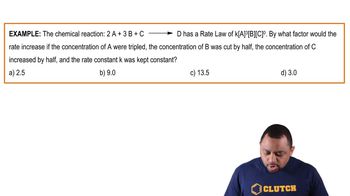Here are the essential concepts you must grasp in order to answer the question correctly.
Rate of Reaction
The rate of reaction refers to the speed at which reactants are converted into products in a chemical reaction. It is typically expressed in terms of concentration change over time, such as moles per liter per second (M/s). Understanding how concentration affects the rate is crucial, as higher concentrations of reactants generally lead to increased reaction rates due to more frequent collisions between molecules.
Recommended video:
Temperature and Reaction Rate
Temperature plays a significant role in influencing the rate of chemical reactions. As temperature increases, the kinetic energy of molecules also increases, leading to more frequent and energetic collisions. This often results in a higher reaction rate. The Arrhenius equation quantitatively describes this relationship, showing how temperature affects the rate constant of a reaction.
Recommended video:
Concentration and Rate Law
The rate law expresses the relationship between the rate of a chemical reaction and the concentration of its reactants. It is typically formulated as rate = k[A]^m[B]^n, where k is the rate constant, and m and n are the orders of the reaction with respect to reactants A and B. By analyzing experimental data, one can determine the order of the reaction and predict how changes in concentration will affect the reaction rate.
Recommended video:
Concentration Changes and Rate Law Example





